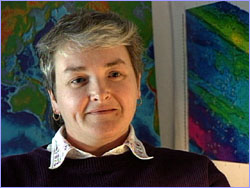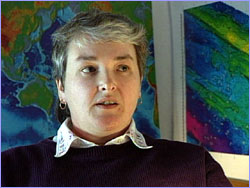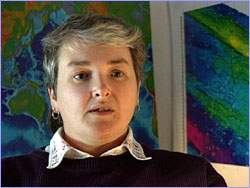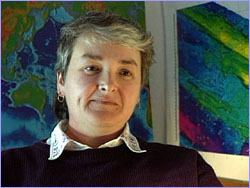
|
 |
 |
 Meet the Team:
Meet the Team:Dr. Deborah Kelley Dr. Deborah Kelley is an Assistant Professor in the School of Oceanography at the University of Washington. On this expedition, she will be the chief scientist aboard the John P. Tully, the research ship that will lift the targeted black smokers off the seafloor. She talked to us about life in a submersible and aboard ship, and the challenges of trying to bring up a smoker. NOVA: What was the most dramatic submersible dive you've ever had? Kelley: The most dramatic for me was the first dive. You're nervous, you don't know what to expect, and you're afraid of doing something wrong. And there's always so much build-up—two years of writing proposals and stuff to get the project going. I was nervous, but I was never worried. When they closed the hatch for the first time, I thought, well, I'm stuck in here. The water was an incredibly iridescent blue color. The sub sinks about 25 meters a minute, and it starts getting darker and darker, and then it looks like you're floating through the stars: these iridescent or phosphorescent critters float by the window. Then it's dark, and you just keep floating down. It takes about an hour and a half. Right before you hit the bottom, they turn the lights on, and you see a completely different environment. The startling thing for me was that, on a first dive into a new area, no one's ever seen it before. If you're not near a vent area, it looks like a desert. There are hardly any life forms at all. It looks almost like a moonscape, only underwater. There are big pillow flows and some sediment, depending on where you are. Then as you start traversing towards the venting area, the biology increases, and you see things like crabs and tubeworms. The first time I saw a black smoker, it was pretty incredible. They just come out of the middle of nowhere, and all of a sudden there's just this huge effusion of biology, a little oasis compared to the area around it. NOVA: What's it like inside the submersible during a dive?  Kelley: It's not a very comfortable environment. It's
very small. I usually dive with people who are tall, so their
feet are in my face for most of the dive. It's cold. They keep
the oxygen low, for safety reasons. There are constant pinging
sounds and little odd noises. The windows are very close to
the floor, so you're always kind of curled up in a fetal
position, looking out the window. And it's tiring. The very
first time I dove, I was completely amazed that I fell asleep
on the ride up. I was so excited, and then we just all knocked
out.
Kelley: It's not a very comfortable environment. It's
very small. I usually dive with people who are tall, so their
feet are in my face for most of the dive. It's cold. They keep
the oxygen low, for safety reasons. There are constant pinging
sounds and little odd noises. The windows are very close to
the floor, so you're always kind of curled up in a fetal
position, looking out the window. And it's tiring. The very
first time I dove, I was completely amazed that I fell asleep
on the ride up. I was so excited, and then we just all knocked
out.But it's really peaceful. There's always good music in the sub. People are in a good mood, and everyone's chattering away. So it's just a fun environment to work in. NOVA: Is it frightening not knowing where you are, or is it exhilarating? Kelley: No, I love just wandering around. You just don't know what you're going to come up on. Especially if you're looking for an area of potential venting. It must have been like when they explored the West and were going across mountain passes, never knowing what was on the other side. NOVA: Is descending to the depths similar to traveling into space? Kelley: Yes. You're in a very small, enclosed capsule in an environment that's difficult to get to, on a mission that takes several years to plan. It involves working with a lot of people very closely. It's very similar to what happens on the space shuttle: The night before you dive, a whole sequence of plans and goals are laid out. It's not just your science; it involves a whole bunch of other scientists who have also worked very hard to have that project come to fruition. And you know that outside of your capsule you're not going to survive very long. You're dependent on that equipment to get you through. So you have a lot of faith in the people that have worked on that—on the sub or space shuttle—that they've done whatever they can to make sure that it's safe. NOVA: Why do you think that the first fields discovered were given these very colorful names of Rose Garden and Garden of Eden?  Kelley: Hydrothermal vent systems are remarkably
colorful. The sulfide materials, when they're fresh, are this
nice orange yellow color. You'll see mats of microorganisms
coating the chimneys that are bright orange and, at times,
bright blue. The tubeworms, if they're active, have white,
almost plastic-like shells or tubes, and inside are bright red
worms. The colors are really vibrant, once you get up close to
the structure.
Kelley: Hydrothermal vent systems are remarkably
colorful. The sulfide materials, when they're fresh, are this
nice orange yellow color. You'll see mats of microorganisms
coating the chimneys that are bright orange and, at times,
bright blue. The tubeworms, if they're active, have white,
almost plastic-like shells or tubes, and inside are bright red
worms. The colors are really vibrant, once you get up close to
the structure.It's also a contrast thing. Ten meters away, it's black. You don't see anything. So, you're driving along in a sub in a dim, ghostly environment, and you see little wisps of things out of the sub window, but if you're not close to them, none of those colors really come out. Then, all of a sudden, you get up close to something that's pumping out 400°C (752°F) fluid, and there are bright red animals, and white crabs and limpets and snails. The contrast is pretty startling. I never get tired of it. NOVA: You discovered the Mothra field, the one from which you'll try to pull up black smokers. What was that like? Kelley: It was during a cruise in 1996. We spent a lot of time exploring with a tool that looks at the water column and can tell if there's some kind of hydrothermal signature. We were able to pinpoint a place within about 50 meters that we were pretty confident was an active area of black smokers. We took the sub down, started wandering around, and came upon some structures that were about 18 meters (60 feet) tall. They were all aligned with one another and looked like picket fences. They were much different than sulfide structures to the north, which are large mounds and have very large flanges. These structures were very tall pinnacles, some of them fairly active black smokers that are covered in animals. You can't even see the minerals underneath the structures, because there's so much biology covering them. NOVA: Is it exciting to be taking part is something that has never been attempted before? Kelley: There's a lot of excitement in the recovery project. It's exciting, but it's also scary. People have put a lot of energy into this. We're all waking up at three in the morning. We decided we might as well have meetings at three in the morning now, because Le, John, and I wake up then, and as soon as we wake up our brains click in, thinking about the project. NOVA: What will it be like being the chief scientist aboard the Tully? Kelley: I've looked forward to being a chief scientist for a long time, but it's hard to get a feeling for what that kind of responsibility feels like. It's one thing to go out there as a scientist: you know your job and you just do it. But it's another thing to make sure that everybody is getting the kind of science they need to get. Especially on the Tully, it's going to be complicated, because there will be a lot of scientists. Everybody wants a piece of the rock, and you want to make sure that happens. NOVA: How hard will this recovery attempt be? Kelley: It's a very hard environment to work in. You've got a mile of water above you. You're using a joystick to manipulate a remotely operated vehicle. We hope we know the sizes of the structures and how hard they are. Nobody's ever cut into these things with a chainsaw. We don't want to cut into one of these structures and have it fall over. We want to cut into it, but have it pinned to its stump, and then have tension so that we can haul this thing under the water under semi-controlled conditions. If it falls over on the seafloor, it's not a disaster, we can still pick up the cage, but what if we cut into it, we don't cut enough, and we end up anchoring the ship to the seafloor? We have contingencies for that, but those are the kinds of problems you have to think about. The other thing is, you have to haul this thing up through a mile of water, it weighs 15,000 pounds out of the air, and you have to physically transfer it from the sea's surface when it could be quite wavy. How do you lift this thing up onto the deck? We have special winches to do that with, but you have to make sure it's good weather. NOVA: You always have to be prepared for stormy seas, right?  Kelley: The lucky scientists get to go in warm weather
conditions, where it's nice and flat and the seas look like
mirrors. But in the northeast Pacific, we are hardly ever that
lucky, and weather's just a thing you have to deal with. You
always plan for a couple of weather days, and if you're lucky
it's only a couple. During a storm, even things that are tied
down can move. When you see 30-foot waves hitting a ship and
the whole ship stops and shudders, it gives you a new view on
safety.
Kelley: The lucky scientists get to go in warm weather
conditions, where it's nice and flat and the seas look like
mirrors. But in the northeast Pacific, we are hardly ever that
lucky, and weather's just a thing you have to deal with. You
always plan for a couple of weather days, and if you're lucky
it's only a couple. During a storm, even things that are tied
down can move. When you see 30-foot waves hitting a ship and
the whole ship stops and shudders, it gives you a new view on
safety.NOVA: What is it about heading out to the wide, open sea that inspires people? Kelley: I love going to sea. I like being away from lots of people and being able to look out on the horizon. You see birds, waves, clouds. You can see forever, and it can be very peaceful. It can also be tense at times, when there are storms. But it's just so different than anything you experience on land. Things are well-defined. You have a very specific purpose, you're away from telephones, and it's a really directed part of your life. I like being with a bunch of people working towards the same thing. For three weeks, everybody has the same goal, everybody's working long hours, and then if you're lucky, you have success. And you can't ask for much better. Interviews: Delaney | Kelley | Mathez | Olson | Shepherd Birth of an Expedition | Mission Plan | Dispatches Through the Porthole | Meet the Team Meet ROPOS (JavaScript/Frames-capable browser required) Meet ROPOS (No Frames/JavaScript) The Mission | Life in the Abyss | The Last Frontier | Dispatches E-mail | Resources | Table of Contents | Abyss Home Editor's Picks | Previous Sites | Join Us/E-mail | TV/Web Schedule About NOVA | Teachers | Site Map | Shop | Jobs | Search | To print PBS Online | NOVA Online | WGBH © | Updated October 2000 |